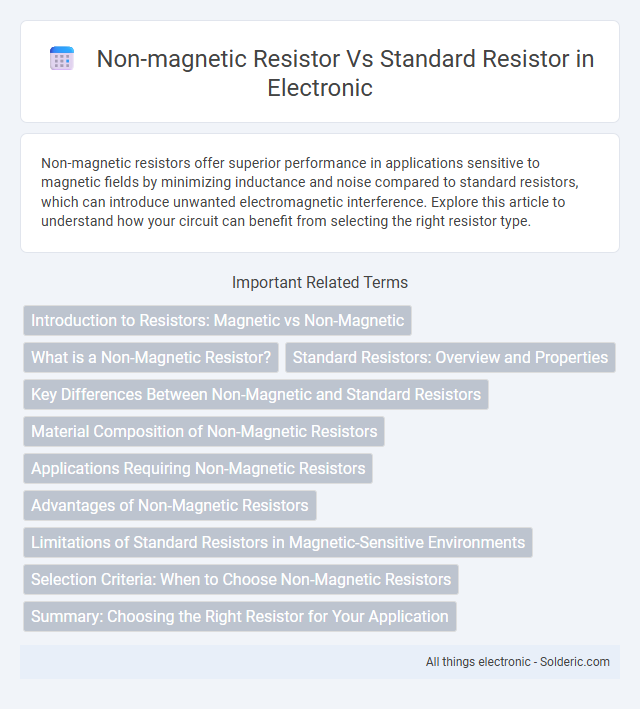Non-magnetic resistors offer superior performance in applications sensitive to magnetic fields by minimizing inductance and noise compared to standard resistors, which can introduce unwanted electromagnetic interference. Explore this article to understand how your circuit can benefit from selecting the right resistor type.
Comparison Table
| Feature | Non-Magnetic Resistor | Standard Resistor |
|---|---|---|
| Magnetic Susceptibility | Minimal to none, ideal for sensitive magnetic environments | May exhibit magnetic effects under strong fields |
| Material Composition | Special alloys like metal film without ferromagnetic elements | Carbon film, metal oxide, or metal film with standard alloys |
| Applications | Medical devices, precision instruments, MRI-compatible electronics | General-purpose electronics, consumer devices, standard circuits |
| Cost | Generally higher due to specialized materials and manufacturing | Lower cost, mass-produced for various uses |
| Performance Stability | High stability in magnetic fields, low noise | Stable under normal conditions but affected by magnetic interference |
| Availability | Less common, niche market suppliers | Widely available globally |
Introduction to Resistors: Magnetic vs Non-Magnetic
Non-magnetic resistors utilize materials such as carbon film, metal oxide, or tantalum nitride to minimize magnetic interference, enhancing performance in sensitive electronic circuits compared to standard resistors, which may contain ferrous components susceptible to magnetic fields. These resistors offer improved signal integrity and reduced noise in applications like precision instrumentation and RF circuits. Standard resistors, often made from metal film or wire-wound, can exhibit inductive properties that affect high-frequency performance and introduce electromagnetic interference in magnetic environments.
What is a Non-Magnetic Resistor?
A non-magnetic resistor is a specialized electronic component designed to minimize magnetic interference and noise in sensitive circuits. Unlike standard resistors, which may contain magnetic materials causing unwanted inductance and signal distortion, non-magnetic resistors use materials like metal oxides or thin films to ensure stable resistance without generating magnetic fields. Your choice of a non-magnetic resistor enhances performance in high-frequency or precision applications where reducing electromagnetic interference is critical.
Standard Resistors: Overview and Properties
Standard resistors, commonly made from carbon film, metal film, or wire-wound materials, exhibit predictable resistance values essential for controlling current in electronic circuits. They typically feature magnetic properties due to metal content, which can introduce inductance and affect performance at high frequencies. Their tolerance ranges from +-1% to +-10%, and power ratings commonly vary between 0.25W to several watts, making them versatile components across various applications.
Key Differences Between Non-Magnetic and Standard Resistors
Non-magnetic resistors utilize materials that exhibit minimal magnetic properties, reducing electromagnetic interference (EMI) and ensuring signal integrity in sensitive electronic applications. Standard resistors, made from carbon or metal films, may introduce magnetic fields that can affect precision circuits and increase noise. Your choice between non-magnetic and standard resistors depends on the need for low EMI and enhanced accuracy in high-frequency or measurement-sensitive environments.
Material Composition of Non-Magnetic Resistors
Non-magnetic resistors are typically composed of materials such as carbon film, metal oxide film, or certain ceramic compounds that exhibit minimal magnetic permeability, distinguishing them from standard resistors which often contain ferromagnetic metals like nickel or iron. The non-magnetic materials ensure that these resistors do not interfere with magnetic fields, making them ideal for sensitive electronic applications, including medical devices and precision instrumentation. Their unique composition reduces electromagnetic interference (EMI) and enhances stability in environments where magnetic fields are present.
Applications Requiring Non-Magnetic Resistors
Non-magnetic resistors are essential in applications sensitive to magnetic interference, such as precision measurement instruments, medical devices like MRI machines, and aerospace electronics where electromagnetic compatibility is critical. Unlike standard resistors, non-magnetic resistors minimize magnetic field distortion, ensuring accuracy and reliability in high-frequency or high-precision environments. Your choice of resistor in these specialized applications directly impacts the performance and safety of sensitive electronic systems.
Advantages of Non-Magnetic Resistors
Non-magnetic resistors offer superior performance in sensitive electronic applications by minimizing electromagnetic interference and maintaining signal integrity. Their construction reduces inductance and noise generation, making them ideal for precision measurement and high-frequency circuits. These resistors enhance circuit stability and reliability where magnetic fields can adversely affect performance.
Limitations of Standard Resistors in Magnetic-Sensitive Environments
Standard resistors can introduce significant interference in magnetic-sensitive environments due to their ferromagnetic components, which distort magnetic fields and degrade measurement accuracy. Non-magnetic resistors, made with materials like metal oxides or thin films, minimize magnetic permeability and reduce inductive effects, ensuring signal integrity. When precise magnetic field measurements or low-noise applications demand high fidelity, choosing your resistor type becomes critical to avoid errors caused by magnetic interference.
Selection Criteria: When to Choose Non-Magnetic Resistors
Non-magnetic resistors are essential in applications sensitive to magnetic interference, such as medical imaging equipment, scientific instruments, and telecommunications devices, where minimal inductance and noise are critical. Standard resistors suffice in general-purpose circuits where magnetic properties do not impact performance or signal integrity. Selection criteria prioritize operational environment, electromagnetic compatibility requirements, and circuit precision demands to determine the appropriate resistor type.
Summary: Choosing the Right Resistor for Your Application
Non-magnetic resistors are designed to minimize magnetic interference, making them ideal for sensitive electronic circuits such as MRI machines or precision measurement devices. Standard resistors offer a broad range of resistance values and tolerances suitable for general-purpose applications where magnetic effects are negligible. Choosing the right resistor for your application involves evaluating the magnetic sensitivity, operating environment, and required electrical performance to ensure optimal functionality and reliability.
Non-magnetic resistor vs standard resistor Infographic

 solderic.com
solderic.com